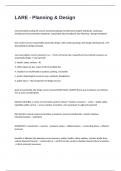LARE - Planning & Design
recommended reading list correct answersLandscape Architectural Graphic Standards, Landscape
Architecture Documentation Standards, Sustainable Sites Handbook, Site Planning + Design Handbook
test content correct answers28% schematic design, 33% master planning, 22% design development, 17%
stewardship & design principles
core assumptions correct answers1. LA --> forms of human dev. respectful of env/cultural resources w/
sustainable design + smart growth
2. health, safety, welfare = #1
3. LOVE mixed-use dev, urban in-fill, brownfield dev
4. emphasis on multimodal circulation, parking, crosswalks
5. protect hydrological resources (esp. wetlands, floodplains)
6. public input = vital component of design process
goals of sustainable site design correct answersMAIN GOAL: ALWAYS find a way to balance soc/cultural,
env, & econ considerations
SOCIAL/CULTURAL (> sense of community, protect cultural + historic resources, < crime, > public safety,
equitable public service, > access outdoor recreation, min neg impact to adjacent property)
ENV (protect natural resources/sensitive ecosystems, preserve biodiversity, consider develop
intensity/location, < pollution)
ECONOMIC (+ investment, > tourism, > property values, + skilled workers, < commuting times, + efficient
land use)
benefits of effective site planning correct answers+ public, health, safety, welfare; +protect public from
natural disasters/hazards, < construction $, > profit from dev, protect valuable natural/cultural amenities,
+ critical economic processes
,stakeholder correct answersa person, entity, or org. w/ interest or concern in a specific
activity/action/outcome (ex: members of public, special interest groups, gov. agencies, elected officials)
how to pick stakeholders correct answers-are directly impacted by issue/project (even if assc'd through
conflict of interest)
-have jurisdiction/control over something relevant to project
-possess specialist knowledge related to project
-directly rep/connected to influential social/comm networks
convener-picked stakeholders correct answersconvener (person/party) organizing public participation
process (usually LA) selects relevant stakeholders
selection committee correct answersa group made to select stakeholders; add'l time but effective for
complex/pol.-sensitive projects
self-nomination correct answersimprecise/open-ended; invitations sent to wide range of potential
stakeholders, and an interested parties decide to attend public outreach events
snowball sampling correct answersrecruitment of participants based on word of mouth or referrals from
other participants; compliment any of the 3 other selection strategies
survey techniques correct answersused to collect project-relevant data from a representative cross-
section of citizens & extrapolate findings from this group to draw conclusions about a larger pop.; must
anticipate response rate to ensure enough data will be collected
formula to calc. total # surveys that must be distributed correct answerssample size / anticipated
response rate = total surveys to be distributed (ex: sample size = 1000 to be valid & response rate = 20%
therefore 5000 surveys should be distributed
a good survey must correct answersbe preceded by pre-notification; contain clear/non-technical
language; have well-delineated purpose clearly stated in an intro; be concise & use graphics as needed;
not overly difficult or time-consuming for participant
,surveys consist of correct answersinterviews & questionnaires
questionnaires correct answersself-administered survey technique; allow respondents to complete
survey at a time of their choosing; anonymous
interviews correct answersa sequence of scripted or unscripted questions led by interviewer; more
flexible b/c introduce unscripted follow-up questions & b/c interviewer can choose to skip questions
visual preference surveys correct answersa visual comparison b/w at least 2 proposed conditions (or
existing vs. proposed); good for pop. that have difficulty reading design drawings (esp. plans); photos or
perspective renderings; usually address scale, massing, transportation, articulation + placement of bldg,
streetscapes, open space/park
needs assesment correct answerstypically used during development of master plan or at beginner of
design process; det. what a specific pop. believes lacking (esp. in built env.); ex: if city dev. new park, they
would conduct needs assmt. to determine what amenities local citizens desire
typical components of needs assessment correct answersID target pop. for study, det. which survey
techniques to use; det. content for public mtgs/surveys; collecting data thru mtgs/surveys; interpreting
data & making summary of findings
other ways to assess needs correct answerssite visits, quantitative techniques (ex: mapping and
calculations to determine a specific level of service [e.g. frequency of a specific amenity per 1000
inhabitants]); this data used to est. comparative relationship b/w ex. conditions & ideal circumstances
(ex: currently 3 playgrounds but 7=ideal)
goal correct answersgeneral statement of intent for the overall design
objective correct answersspecific statements that suggest how goals are going to be accomplished;
action-oriented
meeting types correct answerscommunity visioning (several tools), charettes, public meetings (many
types)
, community visioning correct answersa broad planning activity, community develops shared concept for
future; should 1) reflect core community values; 2) draw from whole of community; 3) address emerging
issues of trends; 4) promote local action; 5) envision preferred future
can be enacted through: 1) task forces; 2) surveys; 3) focus groups; 4) workshops (chose based on
timepoint in visioning process)
charette correct answersintense period of design activity in which multi-disciplinary team works closely
w/ group of stakeholders to develop elements of plan; iterative process (feedback reviewed, several
concepts developed, critiqued, refined, presented to stakeholders, repeat above until final plan created;
good for high-stakes/complex projects; builds trust b/w design team & stakeholders
charettes work best when... correct answersare genuinely collaborative, consider holistic solutions, use
multidisciplinary solutions, use short work sessions, consider several levels of detail, produce feasible
plans, take place on/near project site
informational meetings (type of public mtg) correct answersused to give info to public, get limited
feedback; can be formal or organic
public hearings (type of public mtg) correct answersa forum for gov. officials/public reps to share
info/make decision related to gov's reg. powers
follow specific rules & procedures defined by law; convened by planning & dev. review committee; used
to review/approve/deny/provide specific info related to proposed design project
advisory meetings (type of public mtg) correct answersused to share info; give public greater opp. to
interact w/ public officials & decision makers; begin w/ presentation, end w/ extended period of open,
structured dialogue
workshops (type of public mtg) correct answersdialogue for small group (8-10 ppl) to discuss specific
issue; facilitator-led




